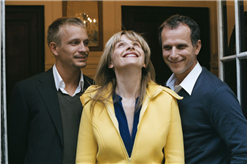
With the royalties he earned from
his novel, A Passage to India (1924),
E.M. Forster was able to purchase a small estate in
“What is the effect of property upon the character? Don’t let’s touch economics; the effect of private ownership upon the community as a whole is another question — a more important question, perhaps, but another one. Let’s keep to psychology. If you own things, what’s their effect on you?”
In his short treatise, “My Wood,”
Forster ponders his predicament. First he notices that property makes him feel
“heavy” — sufficiently stout that he won’t be able to pass through the eye of
the needle into the
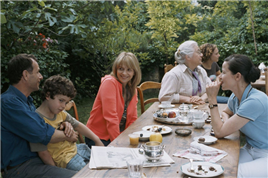
In Olivier Assayas’ uniquely poignant film,
Summer Hours, we find ourselves at the charming country house of a bourgeois family just
outside
In Act II, so to speak, the three
adults gather again at the house, along with spouses, on the occasion of
Hélène’s passing and the incumbent family ritual. In fact, they need to settle the property,
Adrienne and Jérémie having come a long way to do so. Jérémie is a budding businessman who
has now sealed his life abroad, at least for the next five years, by accepting
a managerial position for Puma manufacturing shoes in
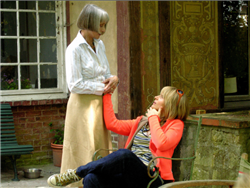
Of course this partial summary leaves out not only Act IV, but the texture and tone of the film, which gather tacitly as the days fly by. There is still the house for our eyes to behold, its faded paint chipping from the woodwork, its walls at one with clinging vines. At every turn, its doors and windows defy a solitary status for this dwelling in the woods. The light pours in, and the interior looks out, the home seeking its place in the landscape. It doesn’t need words for its pleasures: the children know them and grab hold of precious moments there, creating new joys swimming in the pond or frolicking in the fields. They want one last party there for themselves. “I hope they behave,” sighs Frédéric, and his wife asks, “Why?”
One emotional thread of the film is
the growing pains of the adults as they sever themselves from the family unit
and their shared past by confronting the hard facts of the marketplace. For Frédéric, at least, it means his
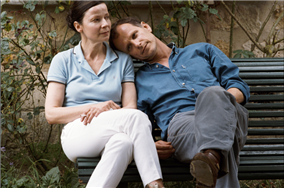
What becomes clear is that it’s not answers Assayas is after in his film, but the genuine experience of ambivalence, or at least a kaleidoscope of viewpoints. He traces the fluctuations of 21st-century life as if they were the flight of a butterfly. As a writer he probes a web of complex themes heavy with global gravitas and personal loss, yet his dramaturgy is as swift and light as the season. Lively as the acting may be, with astute performances all around, bearing the intimacy of improvised exchanges from an ensemble of thespians he knows well, a melancholy hides in the wings, expressed tactfully and lovingly in the music of Robin Williamson and the viola, double bass, and Celtic harp of the Incredible String Band. Eric Gautier’s camera knows when to move and when to be still, ultimately capturing the blues in the light. This push and pull of seemingly polarized ways of presenting the film — heavy and light, fast and slow, moving and still, can be disarming. Along with breaks and gaps in the narrative, a peculiar rhythm emerges — restless, ironic, and often doubling back on itself in a reflexive way.
The special life of objects comes to the fore as they are held in hand, used, turned over, and discussed before their relative “commodification” for restricted and ticketed display at the Musée d’Orsay. They are invested with an anthropomorphic appeal as we first experience them in their domestic habitat, one in which an artist lived and worked and loved, crafting his own expression day by day. Adrienne holds up a silver tray imprinted with the veins of a leaf, her heirloom from her mother, and tells her, “This tray appeared in my dream — it left me and returned to the pond in the woods to be a lily pad again!” The costumes and props of Summer Hours often feel like subjects with their own points of view: Adrienne’s Converse sneakers evoke a behind-the-scenes story of their production, distribution, and use. Immediate and tangible as the film’s setting may be, it is also thick with history, with off-screen economic and social relations scumbled upon each other as multiple layers of meaning.
The hidden life of nature and artifacts haunts the human relations in the film. Surprisingly, the tension between the harmonious pleasures of the atmosphere, with its lush landscape and sensual habitat, and the crass path of the home and its art, “going under the hammer” of commerce and consumerism ,is a quandary that both beguiles and betrays its creator: Assayas, with his own fragmented ties to the past, may be telling the world to “move on” and settle in with the sweeping changes of our century, to sort out nature, art and property among the glistening shards of a new reality; but he is still the Francophile who avidly studied Impressionism and the classical novel and made Summer Hours as an acute postscript to his adaptation of Les Destinées Sentimentales, using much the same cast and crew and dappled light. In this sense, Summer Hours may be more about owning experience than owning property: experience that grows and transforms and spreads itself out as beauty, pleasure, creativity. "I hope that my painting will endure without craquelure. I should like to present myself to the young painters of the year 2000 with the wings of a butterfly," said Pierre Bonnard (an inspiration to the filmmaker) in 1946, a year before he died at the age of 80. That Olivier Assayas saw his mother pass away just prior to shooting Summer Hours is abundantly apparent, for the work stands in homage to the beauty of her legacy.
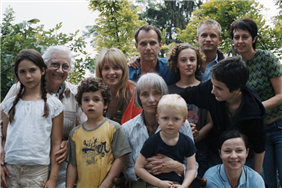
You cannot make Remembrance grow
When it has lost its Root –
The tightening the Soil around
And setting it upright
Deceives perhaps the Universe
But not retrieves the Plant –
Real Memory, like Cedar Feet
Is shod with Adamant –
Nor can you cut remembrance down
When it shall once have grown –
Its iron buds will sprout anew
However overthrown –
Emily Dickinson
Summer Hours
Director: Olivier Assayas; Producers: Marin Karmitz, Nathanaël Karmitz, Charles Gillibert; Screenplay: Olivier Assayas; Cinematography: Eric Gautier, A.F.C.; Sound: Nicolas Cantin, Olivier Goinard; Editing: Luc Barnier; Sets: François-Renaud Labarthe; Costumes: Anaïs Romand, Jürgen Doering.
Cast: Juliette Binoche, Charles Berling, Jérémie Renier, Edith Scob, Dominique Reymond, Valérie Bonneton, Isabelle Sadoyan, Kyle Eastwood, Alice de Lencquesaing, Emile Berling.
Color, 35mm, 102 minutes. In French with English subtitles.